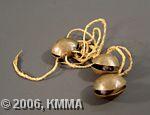



Amayugi ankle bells are classified as idiophones and, like the inzogera, are a kind of folded-over bell with a small narrow slit on the underside. Specifically the amayugi can be described as a smaller version of the inzogera,although the inzogera comprises a single bell, while the amayugi consists of a series of bells tied together. One bell is called iyugi, and is about 3 or 4 cm in size with a slightly flatter shape than the inzogera. The bells have two holes at the top through which a cord is threaded. This is used to attach them to a leather strap 7-10 cm in length. Usually twelve iyugi are tied together, although the number can vary from ten up to as many as twenty. The instruments are made by the village blacksmith, who forges a thin iron sheet (2 mm) up to 9 cm long and 4.3 cm wide in the shape of a broad figure eight. This sheet is then placed on a spherical mould and hammered into a round shape. The other half of the instrument is then made. Before each bell is folded shut a small iron ball is placed inside.
Throughout its long history this group of bells has had various different functions: to protect against spirits, to herd livestock together, to keep robbers at bay, to rout game and to provide the rhythmic beat of dances for both men and women, young and old. When used to accompany dancing, such as the imbyino (popular dance with singing), the amayugi are tied to the ankles of the dancers, who all dance in unison, thus producing the same rhythmic cadence.
The iyugi also has a non-musical function: mothers attach a bell to their young children, while within the Ryangombe cult they are sewn onto headwear.
For more information consult the following publications edited by the RMCA:
© KMMA/Jos GANSEMANS